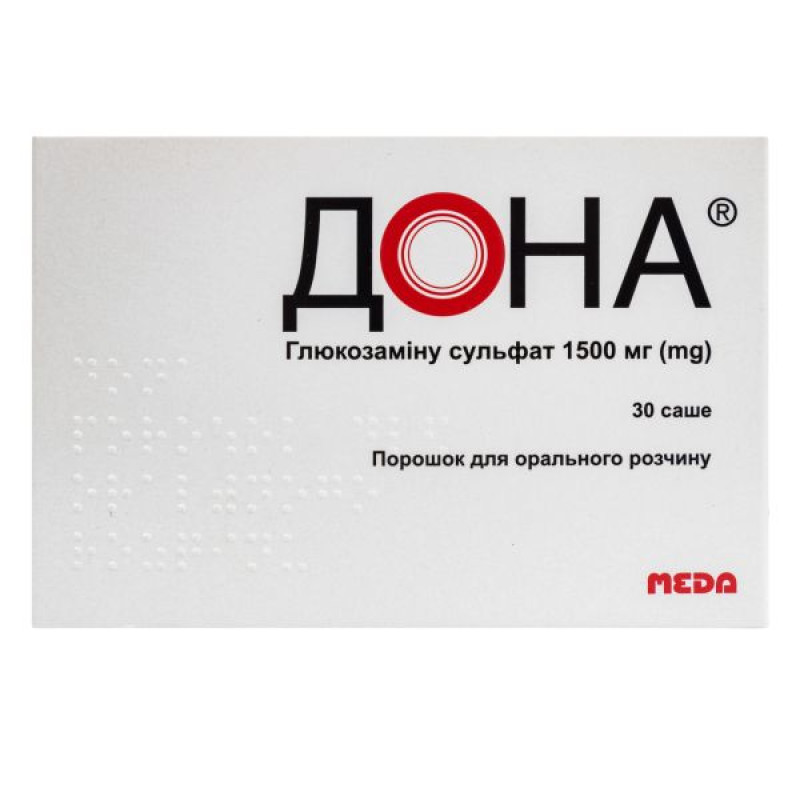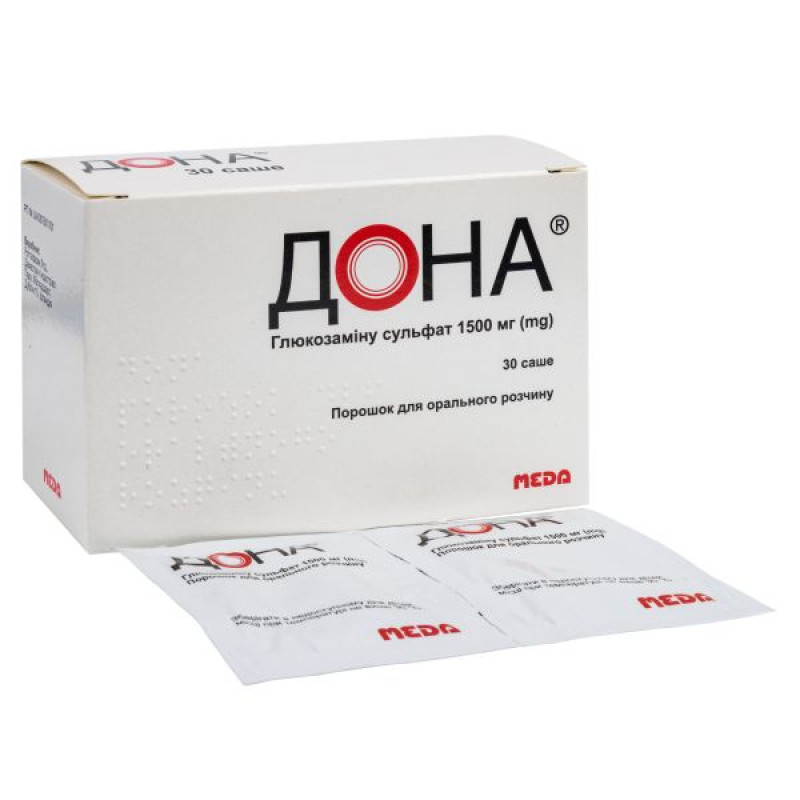Dona powder bag 1500 mg No. 30

Instructions for Dona powder sachet 1500 mg No. 30
Composition
active ingredient: glucosamine sulfate;
1 sachet contains 1884 mg of crystalline glucosamine sulfate, which is equivalent to 1500 mg of glucosamine sulfate and 384 mg of sodium chloride;
excipients: aspartame (E 951), sorbitol (E 420), anhydrous citric acid, macrogol 4000.
Dosage form
Powder for oral solution.
Main physicochemical properties: white, odorless crystalline powder.
Pharmacotherapeutic group
Other nonsteroidal anti-inflammatory and antirheumatic drugs. ATC code M01A X05.
Pharmacological properties
Pharmacodynamics
The active ingredient is a salt of the aminomonosaccharide glucosamine sulfate, which is present in the human body and is used together with sulfates for the biosynthesis of hyaluronic acid in synovial fluid and glycosaminoglycans in the main substance of articular cartilage.
The mechanism of action of glucosamine sulfate is stimulation of the synthesis of glycosaminoglycans and, accordingly, articular proteoglycans. In addition, glucosamine exhibits anti-inflammatory properties, slows down the processes of degradation of articular cartilage mainly due to its metabolic activities, the ability to suppress the activity of interleukin 1 (IL-1), which, on the one hand, contributes to the effect on the symptoms of osteoarthritis, and on the other hand, delays the structural disorders of the joints, as evidenced by the data of long-term clinical studies.
The effectiveness of glucosamine sulfate against osteoarthritis is evident within 2–3 weeks of starting treatment.
Clinical trial results of daily continuous treatment over 3 years show a progressive increase in its effectiveness, with regard to symptoms and slowing of structural joint damage, as confirmed by X-ray.
Glucosamine sulfate has been shown to be well tolerated. No significant effects of glucosamine sulfate on the cardiovascular, respiratory, autonomic, or central nervous systems have been identified.
Pharmacokinetics
90% of the dose of glucosamine sulfate is rapidly and completely absorbed from the gastrointestinal tract, passes through biological barriers and penetrates into tissues, mainly into articular cartilage tissue. Bioavailability – 26%. Half-life – 68 hours.
Indication
For the relief of symptoms in mild to moderate osteoarthritis of the knee.
Contraindication
Hypersensitivity to glucosamine or to any of the excipients; impaired liver and kidney function in the decompensation stage, tendency to bleeding. The drug DONA® should not be used in patients with shellfish allergy, since the active substance is derived from shellfish.
Interaction with other medicinal products and other types of interactions
There is limited data on possible drug interactions with glucosamine, however, increases in INR (international normalized ratio) have been observed with oral vitamin K antagonists. Therefore, patients receiving oral vitamin K antagonists should be closely monitored when initiating or discontinuing glucosamine therapy. Concomitant treatment with glucosamine may increase the absorption and, consequently, the serum concentration of tetracyclines. However, the clinical significance of this interaction is likely to be limited.
Given the fact that only limited data are available on possible interactions with glucosamine, special attention should be paid to any modified response to changes in serum concentrations of concomitantly used medicinal products.
Application features
Before using the drug, you should consult a doctor to rule out joint diseases for which other treatment methods are prescribed.
Patients with impaired glucose tolerance should be cautious when taking glucosamine. In patients with diabetes mellitus, more careful monitoring of blood sugar levels and, if necessary, determination of insulin requirements before starting and periodically during treatment are recommended.
In patients with a known risk factor for cardiovascular disease, monitoring of blood lipid levels is recommended, as hypercholesterolemia has been observed in several cases in patients receiving glucosamine.
The drug should be used with caution in patients with asthma, as such patients may be more prone to developing allergic reactions to glucosamine, with possible exacerbation of the symptoms of their disease.
The powder for oral solution contains aspartame, which is a derivative of phenylalanine, which is dangerous for patients with phenylketonuria.
1 sachet contains 6.6 mmol (151 mg) sodium. This should be taken into consideration by patients on a controlled sodium diet.
The powder for oral solution contains sorbitol. Patients with rare hereditary problems of fructose intolerance should not use this pharmaceutical form.
Use only under medical supervision in patients with impaired liver and kidney function, or with thrombophlebitis.
Use in elderly patients. No specific studies have been conducted in elderly patients, but clinical experience suggests that no dose adjustment is necessary in this patient population.
Use in patients with renal and/or hepatic impairment: Dosage recommendations cannot be made for patients with renal and/or hepatic impairment as no studies have been conducted.
Ability to influence reaction speed when driving vehicles or other mechanisms
Studies of the effect of the drug on the ability to drive a car and other mechanisms have not been conducted. Caution should be exercised when driving vehicles and performing work that requires attention. In case of drowsiness, fatigue, dizziness or visual impairment, driving a car and working with other mechanisms is prohibited.
Use during pregnancy or breastfeeding
There are no data on the use of the drug during pregnancy or breastfeeding, therefore the drug should not be used in this category of patients.
Method of administration and doses
Apply internally.
Adult and elderly patients: dissolve the contents of 1 sachet, equivalent to 1500 mg of glucosamine sulfate, in a glass of water and take once a day, preferably with a meal.
Glucosamine is not intended to treat acute pain symptoms. Relief of symptoms (especially pain relief) may only occur after several weeks of use, and in some cases longer.
If no relief of symptoms occurs after 2–3 months of treatment, treatment should be reviewed.
Children
Do not use in children and adolescents (under 18 years of age) as the safety and efficacy of the drug in such patients have not been established.
Overdose
No cases of overdose have been reported. Based on acute and chronic toxicity studies in animals, symptoms of toxicity are unlikely to occur even when administered in doses 200 times higher than the therapeutic dose. However, in case of overdose, the manifestations of adverse reactions may be exacerbated, so symptomatic treatment should be carried out to restore water and electrolyte balance.
Adverse reactions
The most common adverse reactions associated with the use of glucosamine are nausea, abdominal pain, dyspepsia, flatulence, constipation, diarrhea, headache, fatigue, and drowsiness. These adverse reactions are usually transient and mild in severity.
Criteria for assessing the frequency of adverse drug reactions:
Very common: ≥ 1/10
Common: ≥ 1/100 - < 1/10
Uncommon: ≥ 1/1000 - < 1/100
Rare: ≥ 1/10,000 – < 1/1,000
Very rare: < 1/10,000
Frequency not known: the frequency of occurrence cannot be estimated.
On the part of the immune system: frequency unknown - allergic reactions (hypersensitivity);
Nervous system: often - headache, drowsiness; frequency unknown - dizziness;
On the part of the organs of vision: frequency unknown - visual disturbances;
Vascular system: infrequently - redness;
Respiratory, thoracic and mediastinal disorders: frequency unknown – asthma, exacerbation of asthma;
from the digestive system: often - abdominal pain, flatulence, dyspepsia, diarrhea, constipation, nausea, frequency unknown - vomiting;
Hepatobiliary system: frequency unknown – jaundice;
Skin and subcutaneous tissue disorders: infrequently - exanthema, itching, erythema, rash; frequency unknown - angioedema, urticaria;
general disorders: often - fatigue, frequency unknown - edema, peripheral edema;
Research results: frequency unknown – increased liver enzymes.
Frequency unknown - patients with diabetes may experience a negative effect on blood sugar monitoring.
There have been reports of isolated spontaneous cases of hypercholesterolemia, but a causal relationship has not been established.
Expiration date
3 years.
The expiration date is only valid for products in undamaged original packaging, provided they have been stored correctly.
Storage conditions
Store out of the reach of children at a temperature not exceeding 30 °C.
Packaging
Sachets made of a three-layer material consisting of paper/aluminum/polyethylene, fused together by heating on four sides. 30 sachets in a cardboard box.
Vacation category
According to the recipe.
Producer
Rottapharm Ltd. / Rottapharm Ltd.
Location of the manufacturer and its business address
Damastown Industrial Park, Mulhuddart, Dublin 15, Ireland
There are no reviews for this product.
There are no reviews for this product, be the first to leave your review.
No questions about this product, be the first and ask your question.








